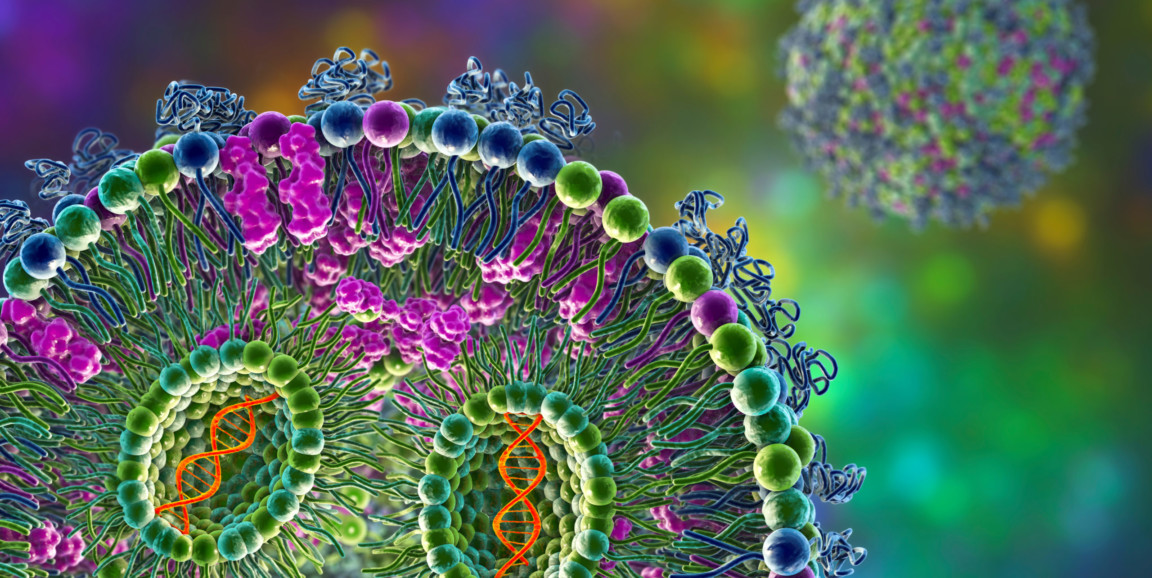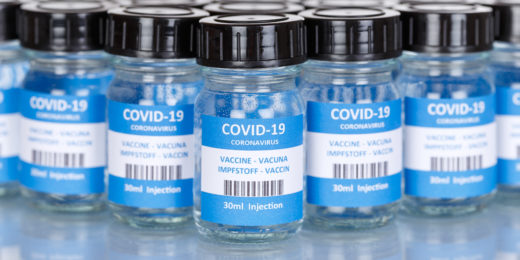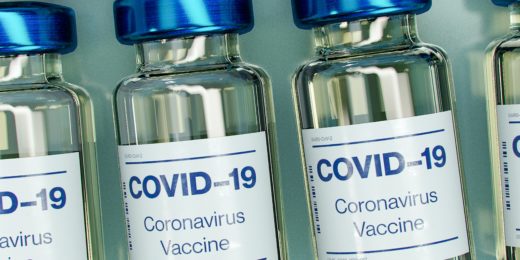This is Part I in a series that will explore the promise, challenges and future of mRNA.
Let's count our blessings.
The COVID-19 pandemic, from which we're still struggling to emerge, has expanded our working vocabulary, gifting the public lexicon with new, if admittedly mostly gloomy, words and concepts. (Examples: spike protein, intubation, N-95, rapid antigen test.) We may not flood our speech with these terms, but we're at least passingly familiar with them now.
Emerging last but not least, like hope climbing gamely out of Pandora's box, is a more upbeat little noun: mRNA. Once known only to biology majors, mRNA -- more formally named messenger RNA -- has entered society's word list, courtesy of a brand-new kind of vaccine.
Rarely has vaccine development exceeded the speed of paint peeling. But mRNA vaccines were hustled into commercial viability by Operation Warp Speed, a federal program set up in 2020 to accelerate the development of any vaccine that might stave off COVID-19's most severe symptoms.
Since getting an emergency use authorization by the Food and Drug Administration in December 2020, more than 12 billion mRNA-based COVID-19 vaccine doses have been shot into people's arms. They've outperformed other COVID-19 vaccines made through traditional means, with respect to both safety and efficacy. Today, scientists are developing mRNA vaccines for all kinds of other infectious diseases, as well as cancer.
There are solid reasons why mRNA may be a superior material for many vaccines, especially when pathogens keep swiftly evolving new strains. But realizing mRNA's full potential means addressing some non-negligible challenges, which Stanford University researchers are tackling. Among them: how to get more bang for the dose; and how to send that dose to only where it's supposed to go. The solutions could hinge on how it gets delivered.
mRNA's wild ride on the fat-blob express
The cell nucleus, home to our genome, doesn't let any of the 22,000-odd genes it encloses leave the premises. But those DNA-constituted genes can be copied in the form of smaller strands of RNA, a DNA-doppelganger substance that can exit the nucleus. Every mRNA molecule's mission is to carry the genetic recipe for whatever protein it encodes (hence the "m" for "message") to the cytoplasm -- all the cell's territory outside the nucleus. That's where abundant numbers of a type of molecular machine -- protein-printing presses called ribosomes -- hang out. Ribosomes know how to read any mRNA recipe and cook up a batch of the indicated protein in a jiffy. These are well-oiled machines honed by eons of evolution.
By contrast, making proteins outside of cells is typically a fussy business. Just as different culinary creations require vastly different ingredients -- cooking vessels, timing, mixing methods and oven temperatures -- every protein has its own peculiar manufacturing specs.
mRNA technology's success lies in outsourcing the heavy lifting of protein manufacturing to the ultimate protein factories: our own cells, which can host up to millions of ribosomes apiece -- all the state-of-the-art protein-producing equipment you could ask for. Those ribosomes don't care where the mRNA came from, by the way. Scientists can feed a ribosome any strand of mRNA and it'll crank out multiple copies of whatever protein that strand designates, folded into just the right shape to do its intended job.
That's good news for the biotechnology industry, which can rapidly synthesize buckets of mRNA molecules specifying any desired protein, or chunk of one -- for example, from a pathogen. (Proteins or chunks of them are what make up most vaccines. Exposure to them trains the immune system to launch an attack on that pathogen.)
Fine. So, making mRNA is a snap for biotechnologists. But getting it to the right cells and, once inside, to the ribosomes ... that requires ingenuity. Simply shoot naked mRNA into someone's veins, and it will quickly get chewed up by enzymes in the blood or tissues. It's very delicate. And mRNA can't whiz effortlessly through cells' protective outer membranes.
You need a delivery vehicle.
The COVID-19 mRNA vaccines have been ushered into our cells via workhorse delivery trucks called lipid nanoparticles (lipid being a scientific term for "fatty stuff"). Lipid nanoparticles, or LNPs, are glorified fat globules.
"An LNP is a crude attempt to do what a virus does for a living," said Stanford University professor of chemistry Bob Waymouth, PhD. "Viruses are really good at getting inside cells so they can replicate themselves."
A lipid nanoparticle is a four-ingredient sphere roughly 100-200 nanometers in diameter (coincidentally, the size of the virus that causes COVID-19). Two ingredients stabilize the lipid nanoparticle's chemical composition. One prevents lipid nanoparticles from clumping up, as fat blobs are inclined to do. The fourth, linchpin ingredient is a bunch of linear, fatty molecules carrying a generally positive electrical charge along their lengths. An mRNA strand is negatively charged along its length. And as we all know (particularly in electronics), opposites attract. So, the two stick together, anchoring the mRNA to the lipid nanoparticle. A single lipid nanoparticle can encase multiple mRNA molecules.
Lipid nanoparticles are formulated to deliver their mRNA cargo safely into cells and release it. This frees the mRNA molecules to skedaddle into the cytoplasm and clamber onto its resident ribosomes. But in practice, only around 10% of mRNA smuggled into a cell by lipid nanoparticles ever actually wind up producing proteins.
"LNPs have a problem with letting go," Waymouth said.
Another problem: Most lipid nanoparticles never get to the desired cells in the first place. Once injected, lipid nanoparticles tend to gravitate toward certain organs and cell types. Left to their own devices after intravenous injection, the vast majority head for the liver -- super, if you're attempting to medicate liver cells. (Companies all over the world are working on mRNA-based medicines designed to do just that, Waymouth said.) Otherwise, not so great.
COVID-19 shots are, of course, injected into muscle tissue, not veins. Even so, some of the lipid nanoparticle-borne mRNA lands in the liver, animal trials suggest. More gets into muscle cells. Small amounts wind up in still other places, which Waymouth said could possibly account for some of the side effects of the COVID-19 vaccine.
Fortunately, a fair amount of it reaches front-line sentinel "show-and-tell" cells of the immune system hanging out in muscle tissue or nearby lymph nodes. These immune cells are ideal vaccine targets. They gobble up lipid nanoparticles, follow the ingested mRNA's instructions and make proteins, which they chop up into little pieces and display on their surfaces for other immune cells to recognize as foreign material -- a key step in kicking a coordinated immune response into gear.
Lipid nanoparticles aren't overly toxic in themselves, but they do cause some inflammation and could be responsible for some of the more common side effects of COVID-19 vaccines we do see, such as sore arms, fever, redness, etc.
Some side effects are more worrisome -- for instance, myocarditis, a rare inflammation-driven heart problem experienced primarily by young men and adolescent boys. Whether or not lipid nanoparticles' inflammatory potential, plus their tendency to wander off, might contribute to some of these less frequently observed, but troubling, COVID-19 vaccine-associated symptoms is an open question. (COVID-19 itself imparts a greater myocarditis risk.)
It's a reasonable bet that if biomedical scientists could direct mRNA to targeted cells or organs and nowhere else, this might lower the risk of side-effects. What's inarguable is that less of the vaccine would need to be injected. With less going to waste, there'd be more to go around. That's worth considering when you're trying to vaccinate the world's whole population, or close to it, all at once.
There may be a way to do just that. Newer, more efficient, more targeted ways of packaging mRNA could provide a powerful boost for its expanded use in treating conditions beyond mRNA.
Read all the stories in this series:
Part I: Special delivery - an mRNA explainer
Part II: Special delivery 2.0: CARTs
Part III: mRNA medicines: Looking back, and a look forward
Photo by Kateryna_Kon






